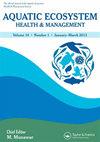Temporal variabilities of δ13C and δ15N in an ecosystem from the Central-East Gulf of California: estimating trophic relationships
IF 0.8
4区 环境科学与生态学
Q4 ENVIRONMENTAL SCIENCES
引用次数: 2
Abstract
The foodweb of El Tóbari Lagoon (central-east Gulf of California) was studied for four seasons through the carbon and nitrogen isotopic characterization of primary producers, invertebrates, fish, birds and potential food sources. The range of δ13C measured was much wider for potential food sources than for consumers. Many organisms presented enrichments of δ13C and δ15N values. There was a clear trend toward increasing δ13C and δ15N from base organisms to top-predators in the four seasons. The isotopic and percentage of contribution data confirmed that suspended particulate organic matter and phytoplankton are the main organic source supporting the foodweb. Our results also imply the occurrence of a nutrient transfer from zooplankton to some invertebrates and juvenile fishes. Consumers were composed in four trophic levels, with trophic level 2 occupied by zooplankton and filter-feeders and trophic level 4 occupied by carnivorous fish and most bird species. Carnivorous fish exhibited dietary similarities by a considerable sharing of resources, which could be related to the abundance of possible prey, between invertebrates and juvenile fishes. Crustaceans and fish represented the main food sources of birds, although some birds showed more dietary variation (marine and offshore prey).加利福尼亚湾中东部生态系统δ13C和δ15N的时间变化:营养关系的估计
通过对主要生产者、无脊椎动物、鱼类、鸟类和潜在食物来源的碳和氮同位素特征,对El Tóbari泻湖(加利福尼亚湾中东部)的食物网进行了四季研究。潜在食物来源的δ13C测量范围远大于消费者。许多生物呈现出δ13C和δ15N值的富集。δ13C和δ15N从基础生物到顶级捕食者在四季中有明显的增加趋势。同位素和贡献百分比数据证实,悬浮颗粒有机物和浮游植物是支持食物网的主要有机来源。我们的研究结果还表明,浮游动物向一些无脊椎动物和幼鱼转移了营养物质。消费者分为四个营养级,其中2级由浮游动物和滤食性动物占据,4级由食肉鱼类和大多数鸟类占据。食肉鱼类在饮食上表现出相似性,因为无脊椎动物和幼鱼之间有相当多的资源共享,这可能与可能的猎物数量有关。甲壳类和鱼类是鸟类的主要食物来源,尽管一些鸟类表现出更多的饮食变化(海洋和近海猎物)。
本文章由计算机程序翻译,如有差异,请以英文原文为准。
求助全文
约1分钟内获得全文
求助全文
来源期刊

Aquatic Ecosystem Health & Management
环境科学-海洋与淡水生物学
CiteScore
1.70
自引率
0.00%
发文量
1
审稿时长
18-36 weeks
期刊介绍:
The journal publishes articles on the following themes and topics:
• Original articles focusing on ecosystem-based sciences, ecosystem health and management of marine and aquatic ecosystems
• Reviews, invited perspectives and keynote contributions from conferences
• Special issues on important emerging topics, themes, and ecosystems (climate change, invasive species, HABs, risk assessment, models)
 求助内容:
求助内容: 应助结果提醒方式:
应助结果提醒方式:


